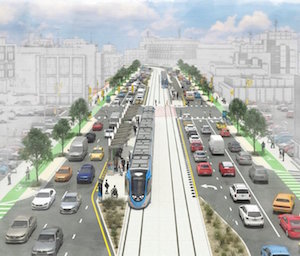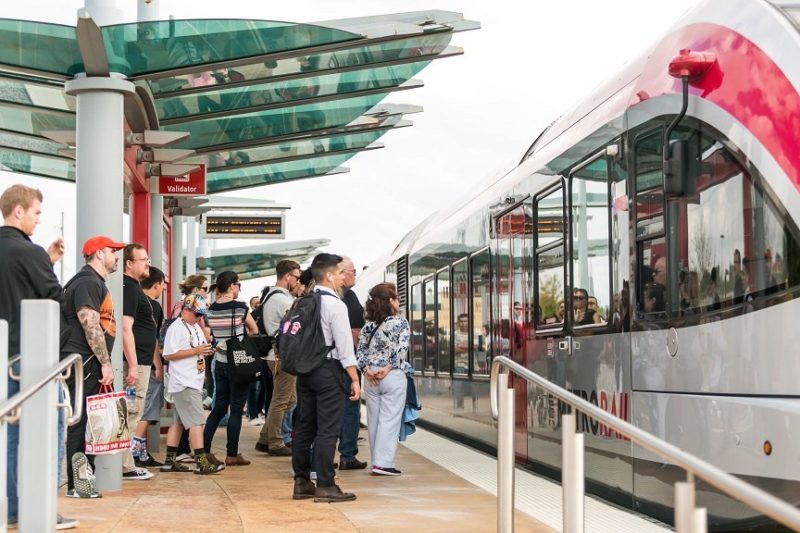Opponents of Project Connect, the long-range mass transit plan that voters will likely be asked to approve in November, can talk all day about what’s wrong with the plan.
Here are the recurring critiques:
- It’s really expensive.
- Most people won’t use it.
- It will take too long to build
To which I say, “What’s the alternative?”
I suppose some might actually believe that no alternative is necessary because Austin’s transportation system is just fine as it is. Perhaps they even believe that it will continue to be fine as the Austin metro area’s population doubles over the next 20 years.
But I doubt that’s the case. Or at least I can’t imagine that’s what they’d want to tell voters, lest they be rightly judged as delusional. Most Austinites don’t need to look at the numbers to tell you that getting around this city is a headache, but the numbers aren’t pretty either. The Capital Metropolitan Planning Organization, a regional transportation planning agency that oversees Austin’s 6-county metro area, projects that average travel times will more than double by 2045 if the system remains the same.
Our Mobility Our Future, the political action committee opposing Project Connect, tells us that a major investment in public transportation is not the answer. Instead, they imagine a future in which shared bikes/scooters, increased teleworking and fleets of autonomous ride-sharing services solve congestion and people will be able to get around more easily, safely and affordably.
Sounds like a dream come true. But right now it’s just a dream and we don’t know if and when it will come true. Our Mobility Our Future asserts, without any evidence, that autonomous ride-sharing services (imagine a fleet of driverless Ubers and Lyfts) will be here five years from now and that light rail will be “obsolete” by the time it is built. And yet, a task force of experts convened by MIT to assess the future of autonomous technology recently said that “the widespread deployment of fully autonomous vehicles that have no safety driver onboard will take at least a decade” and that the technology should be viewed as “a feeder for public transit rather than a replacement for it.”
The second problem is that if and when autonomous vehicles become widely available, they don’t solve one of the fundamental challenges: geometry. Our roads are clogged because there simply isn’t enough space for the number of drivers. Even if driverless cars crash less and make fewer mistakes than humans, there is only so much they can do to reduce congestion as our population rapidly rises.
“Autonomous vehicles don’t solve one of the fundamental challenges: geometry.”
Finally, it’s far from clear how affordable autonomous ride-sharing will be in the long-term. It’s a huge leap of faith to assume that it will be cheaper than existing ride-share services. Despite their popularity, neither Uber or Lyft has ever turned a profit. Although autonomous vehicles would allow them to discard one big expense (the driver), it would force them to assume another one (the vehicles).
All of these challenges help explain why many supporters of autonomous vehicles describe them as a partner with public transit, not a competitor. That’s why Ford Autonomous Vehicles, which already has a small number of driverless cars deployed in Austin, is one of a number of locally-based businesses that are part of the Transit for Austin coalition that was formed to advance Project Connect.
Now let’s discuss the price of Project Connect. The full project is projected to cost $7 billion, $3.85 billion of which will be paid for by the city and the rest by the federal government. That will translate to a little under a $300 annual property tax hike for the median city homeowner ($325,000 value). That’s a tall ask in the midst of a recession.
And yet, the cost of the alternative is so much higher. We are not facing a question of whether we spend an enormous amount on infrastructure, but how we spend that money.
Consider that the state is now planning to spend $8 billion to expand a 20-mile segment of I-35. Consider that the city plans to spend $575 million over the next five years just on roadway expansion projects.
The alternative to Project Connect is to double-down on the status quo. If we don’t provide alternatives to car-based transportation, we will be forced to continue to pour billions and billions of additional dollars into paving over more of Central Texas. And by failing to offer people alternatives to cars, we are forcing low and middle-income people to devote a huge percentage of their income to car ownership. Even cheap cars are expensive: Edmunds, the online car market, estimates that a used 2014 Toyota Corolla will cost the average buyer $25,704 over five years.

That approach is not only wasteful economically and terrible environmentally, but it has a terrible track record on actually relieving congestion. Once a metro area becomes big enough, the benefits of adding roadway capacity begin to diminish due to a phenomenon known as “induced demand,” where the added capacity draws more traffic, eventually bringing the road back to the same state of congestion.
Just look at Houston. Fifteen years ago the region faced a major traffic crisis on I-10, better known as the Katy Freeway. The city responded with a $2.8 billion expansion between 2008-11 that resulted in a 26-lane monstrosity that is by some accounts the widest highway in the world. And yet, within a few years of completion, commuters on the freeway were facing even longer delays than before the project.
Light rail does not present the same issues. Instead of inducing traffic, it actually reduces it by getting people off the road. In the long-term it is also much better at scaling to meet the growing population, since it’s much easier to add another car onto a train than it is to widen a road.
It’s true that most people won’t rely on these two rail lines initially, but the same could be said of any infrastructure project. I can’t remember the last time I drove on Parmer Road. Does that mean my taxes shouldn’t fund it? Of course not. Project Connect is not just two rail lines and a series of new bus routes; it’s the foundation of a system that will grow over not just the next 10-20 years, but the next 50-100 years.
Our Mobility Our Future, the group urging us to reject Project Connect, says we need to “move forward — not backwards.” I agree. But they’re not offering a way forward. They’re offering a fantasy that won’t move us anywhere.
Jack Craver is the author of the Austin Politics Newsletter, which provides breaking news and insider insights on city politics every weekday morning. Sign up here for a free trial.
